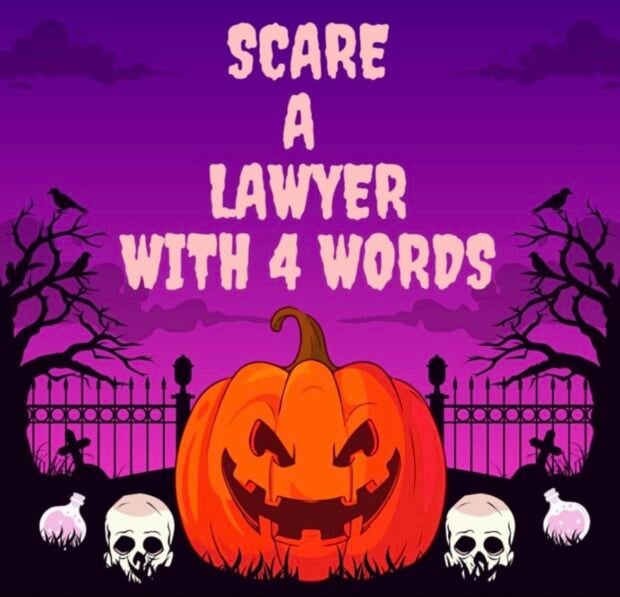When
it
comes
to
finding
precedent
deal
data
and
what’s
market,
transactional
lawyers
are
frustrated.
It
often
takes
in
excess
of
6-8
hours
to
find
a
precedent
deal
and
identify
relevant
deal
points
from
firm
documents.
And,
even
then,
lawyers
may
not
feel
they
are
getting
a
complete
picture
of
the
data.
Now
multiply
these
hours
exponentially
when
all
recent
precedent
deal
points
are
needed
as
a
reference
for
drafting
and
negotiation.
For
many
lawyers,
the
process
is
further
frustrated
by
the
number
of
steps
—
and
people
—
required
for
manual
deal
data
extraction.
When
a
new
deal
comes
in,
or
a
client
is
in
immediate
need
of
critical
information,
lawyers
start
the
hunt.
Often,
details
can’t
be
found
quickly,
and
others
are
engaged.
An
urgent
email
goes
out
looking
for
help.
From
accounting
to
knowledge
management
to
business
development,
professionals
across
the
firm
drop
everything
to
help
with
the
search.
Other
priorities
are
put
on
hold
as
the
team
scrambles
to
assemble
the
information,
often
from
various
sources,
all
while
the
client
waits.
The
team
puts
together
the
best
information
they
can
find
and
hopes
it
will
be
enough.
Regardless
of
the
outcome,
this
is
not
an
ideal
process.
Enter
Litera’s
new
solution
for
transactional
lawyers
and
knowledge
management
teams:
Foundation
Dragon.
This
easy-to-use
platform
helps
lawyers
instantly
answer
complex
questions
by
using
GenAI
to
extract
deal
points
from
firm
deal
documents
and
pairing
it
with
matter
experience
data
to
quickly
and
accurately
get
you
the
answers
you
need,
when
you
need
them.
That
6-8
hours
it
can
take
an
associate
to
pull
deal
points
from
just
one
deal?
It’s
now
cut
down
to
minutes.
Furthermore,
all
of
your
firm’s
deals
are
in
one
searchable
place,
so
finding
the
most
relevant
precedent
deals
and
their
deal
points
for
comparison
is
simple
for
any
attorney
to
find
—
no
staff
needed.
The
tool
verifies
data
with
minimal
human
input,
ensuring
the
highest
standard
of
accuracy
while
still
being
simple
and
intuitive.
Getting
Started
Lawyers
typically
lack
the
time
to
learn
a
complex
new
system,
and
ease
of
onboarding
is
a
key
goal
for
any
legal
technology
tool.
Foundation
Dragon
is
intuitive
and
easy
to
use.
When
a
deal
closes,
simply
upload
the
closing
documents
to
Dragon,
select
the
appropriate
deal
type
and
Dragon
will
extract
and
load
the
deal
data
from
the
documents
into
the
system
quickly
and
easily.
To
help
get
a
new
system
off
the
ground,
Litera
also
offers
a
service
to
pre-populate
Foundation
Dragon
with
all
of
a
firm’s
historical
data.
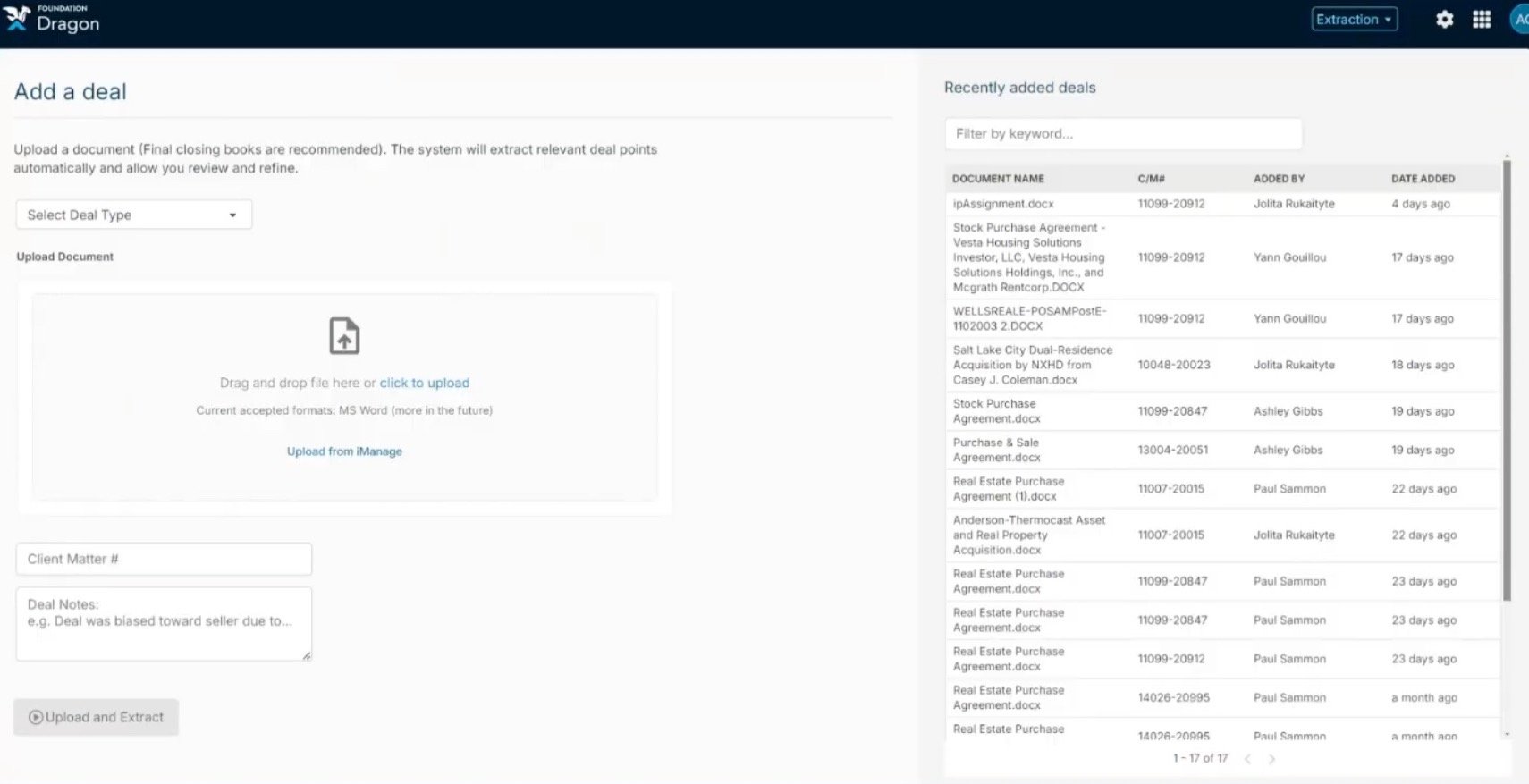
Contrast
this
process
with
that
of
many
law
firms,
which
collect
experience
data
by
circulating
a
blank
survey
form
to
a
transaction
team.
The
latter
approach
requires
lawyers’
time
and
effort
to
fill
a
blank
page
—
and
often
achieves
mixed
results
in
collecting
usable
data.
With
Foundation
Dragon,
the
system
will
automatically
extract
nearly
300
deal
points
for
an
M&A
transaction
within
minutes
of
a
document
upload,
and
the
commercial
real
estate
acquisition
version
of
Foundation
Dragon
extracting
over
90
deal
points.
Foundation
Dragon
now
supports
several
new
document
types,
including
commercial
real
estate
leases,
credit
agreements,
limited
partnership
agreements,
and
NDAs,
with
plans
to
introduce
more
in
the
coming
year.
The
system
then
delivers
a
populated
dashboard
of
all
the
deal
points
that
have
been
extracted.
Instead
of
a
blank
survey,
a
transaction
team
receives
a
pre-existing
draft.
They
only
need
to
verify
the
accuracy
of
the
deal
point,
and
the
process
for
doing
so
is
intuitive.
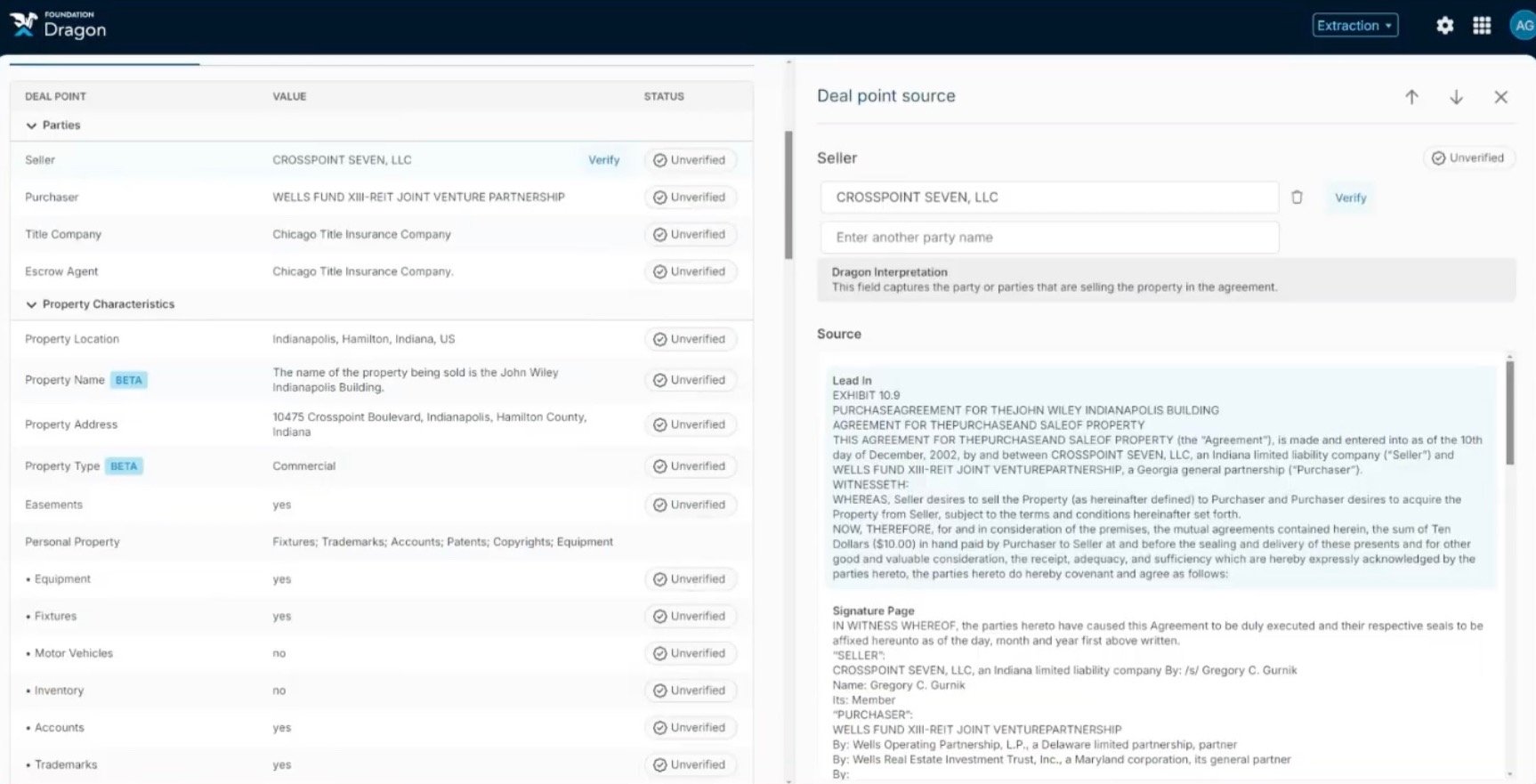
A
click
on
a
deal
point
value
automatically
brings
up
the
relevant
portion
of
the
underlying
document.
With
one
click
of
the
button,
the
deal
point
can
then
be
marked
“verified”
in
the
system
or,
on
rare
occasions,
edited
to
the
correct
figure.
This
creates
a
workflow
where,
after
the
closing
of
a
deal,
an
attorney
who
worked
on
the
matter
can
verify
all
of
the
deal
points
in
a
matter
of
minutes.
The
extracted
deal
points
will
then
be
accessible
to
all
lawyers,
be
included
in
aggregate
metrics,
and
be
available
for
marketing
and
business
development
efforts. Foundation
Dragon’s
insights
become
even
more
impactful
when
combined
with
Litera’s
experience
management
solution,
Foundation,
as
it
allows
you
to
push
the
extracted
deal
data
over
to
Foundation’s
matter
profiles.
This
means
firms
can
reap
the
benefits
of
automatically
populating
enhanced
deal
profiles
in
Foundation
with
minimal
effort.
Accessing
Your
Insights
Once
your
deals
have
been
uploaded
into
the
system,
your
users
can
put
the
data
to
work
through
an
efficient,
user-friendly
interface
that
displays
all
of
the
metrics
that
have
been
collected.
One
view,
called
“market,”
contains
all
of
the
deal
points
as
aggregate
metrics,
based
on
every
deal
the
firm
has
uploaded.
The
resulting
dashboard
allows
you
to
instantly
answer
the
question
of
“what’s
market?”
for
any
of
the
deal
points
the
system
collects.
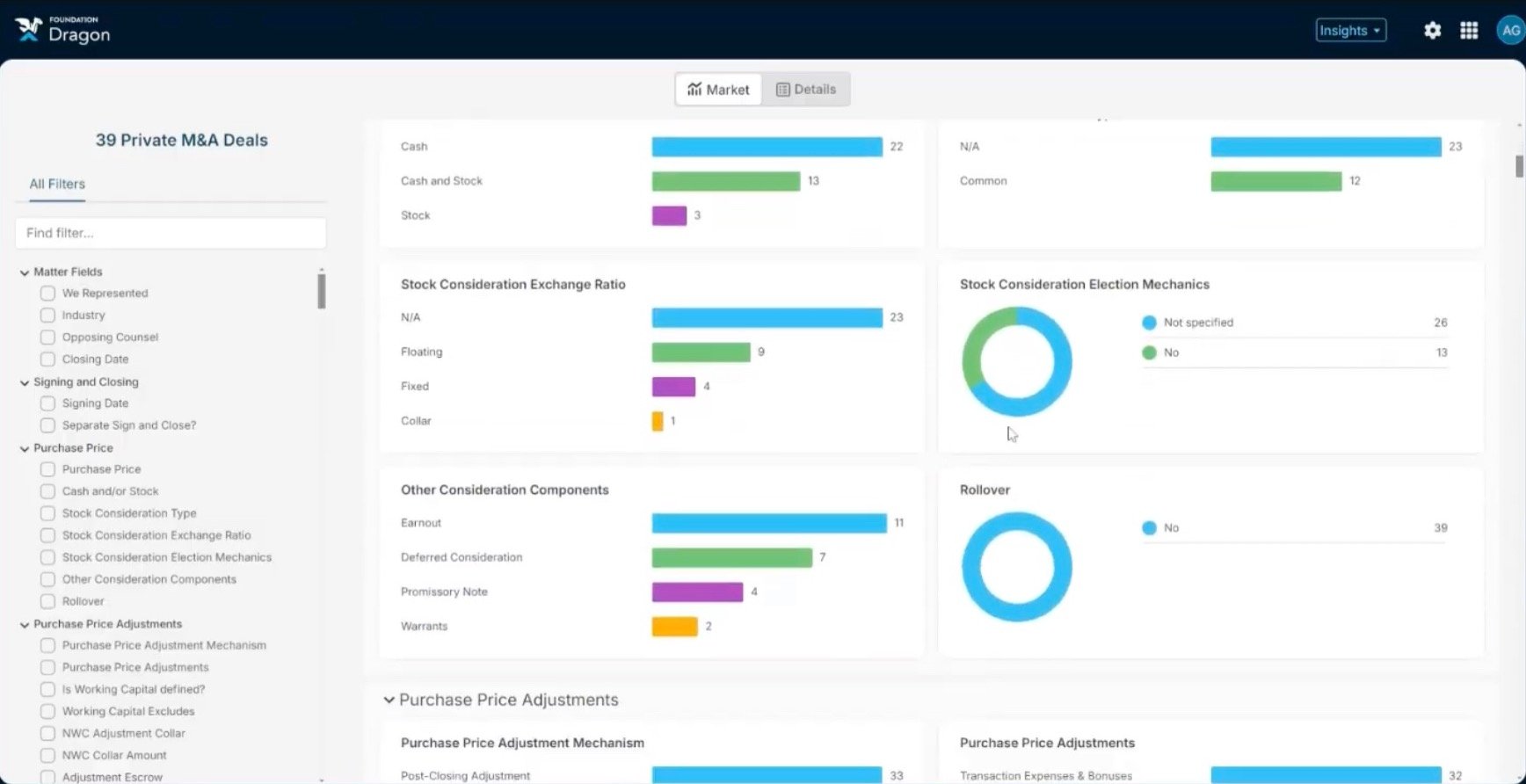
Looking
for
insights
based
on
a
specific
matter
or
group
of
matters?
A
few
clicks
narrow
the
data
points
down
to
that
subset.
Each
deal
point
here
represents
the
type
of
data
that
would
often
have
to
be
found
by
having
a
knowledgeable
professional
comb
a
200-page
document
for
hours
on
end.
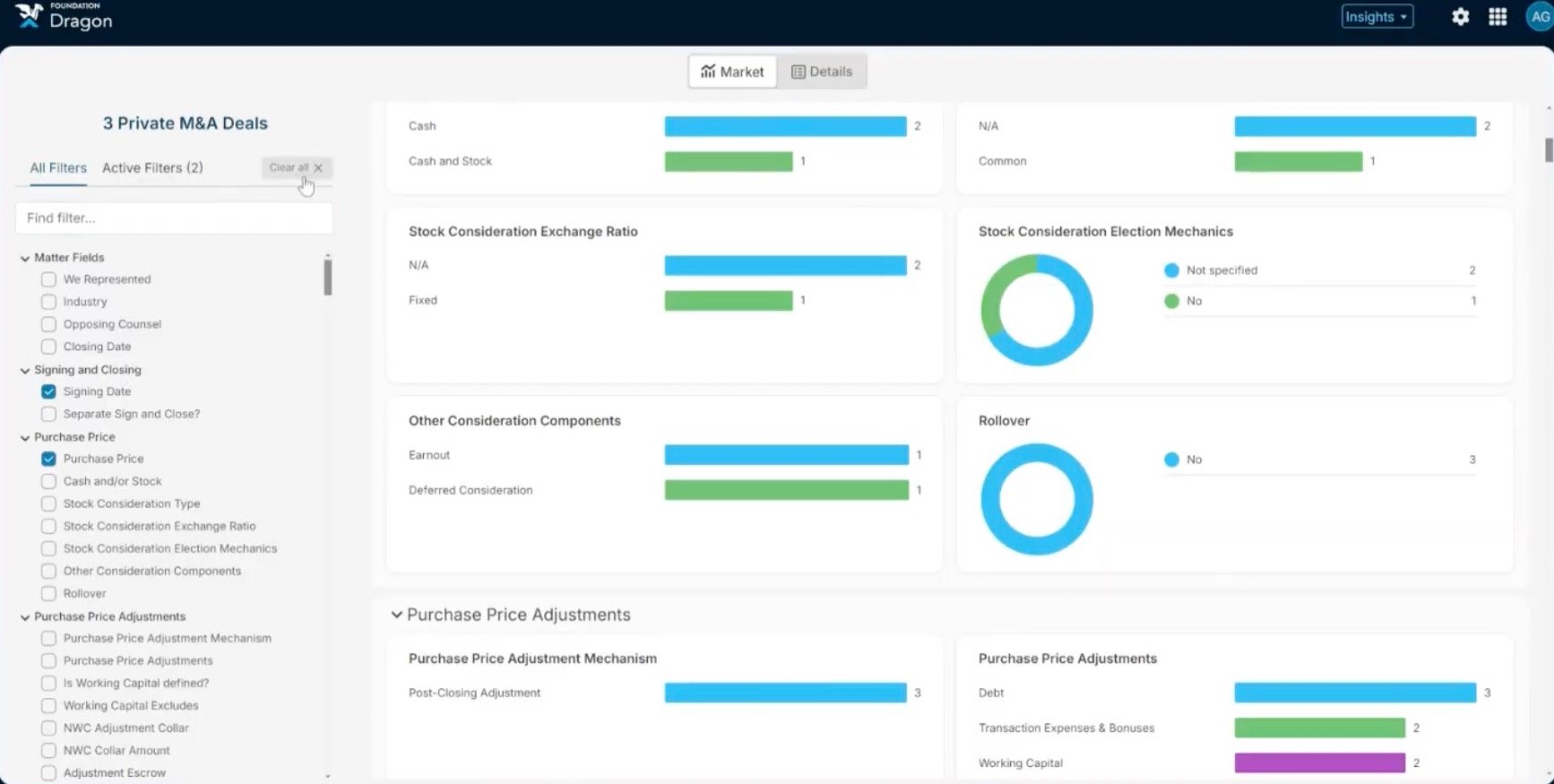
A
group
of
up
to
five
deals
can
be
compared,
and
the
data
can
be
directly
exported
to
Excel.
The
simplicity
of
the
design
is
particularly
helpful
when
comparing
deals.
Here,
all
of
the
deal
points
being
compared
are
laid
out
right
next
to
each
other
for
easy
visualization.
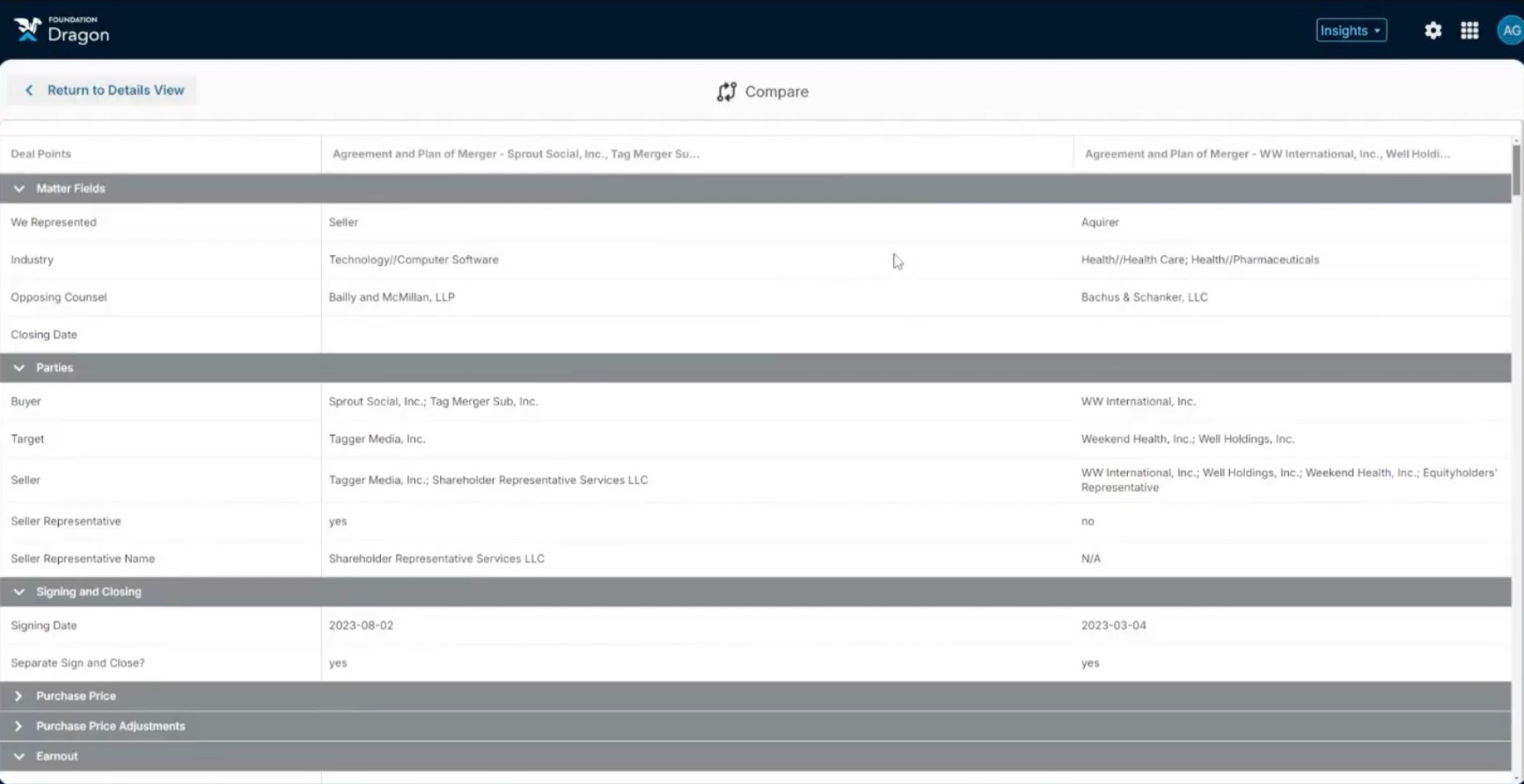
From
document
upload
to
data
visualization,
Foundation
Dragon
provides
a
simple,
intuitive
process
that
requires
minimal
onboarding
while
delivering
impactful
insights
that
save
lawyers
time
and
a
client
billable
hours.
Putting
Data
to
Work
For
the
legal
industry,
manually
curating
data
from
transactions
has
long
been
a
time-consuming
task
requiring
skilled
practitioners
and
delivering
mixed
results.
Some
firms
have
devoted
decades
to
creating
a
bespoke,
reasonably
efficient
process.
These
firms
have
distinct
advantages
in
accessing
data-driven
insights
from
precedential
deals
when
negotiating
transactions
and
advising
their
clients.
Firms
that
lack
such
a
system
often
rely
on
“reply
all”
emails
and
firmwide
fire
drills
instead
—
a
process
that
needlessly
consumes
resources
and
delivers
inferior
results.
As
Foundation
Dragon
shows,
this
is
a
situation
that
can
be
effectively
addressed
by
generative
AI.
Foundation
Dragon
offers
elite
data
tracking
and
reporting
to
all
transactional
lawyers
—
with
only
minimal
effort
on
the
lawyers’
part
to
get
it
up
and
running.
Dragon
gives
lawyers
the
ability
to
negotiate
from
a
position
of
strength
and
deliver
unparalleled
client
outcomes.










 Kathryn
Kathryn










